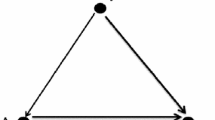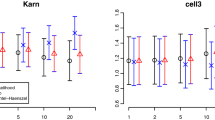Abstract
The purpose of this paper is to illustrate the important but often neglected role which time has in the statistical treatment of causal problems. Another motivation is to provide a demonstration of how the tools offered by Bayesian modeling and inference, which likewise seem to have largely been ignored in the mainstream statistical literature on causality, can be usefully applied in this context. To offer a concrete example, I consider a particular problem, exploring the effect which the type of day care appears to have on the incidence of acute middle ear infections in small children. Existing epidemiological knowledge is used in setting up a stochastic model, which is formulated in terms of a suitably defined marked point process and applying non-parametric specification of model components where such prior knowledge seems vague. In this context, the important role of the concept of local independence is stressed. A combination of Bayesian inferential methods and an application of MCMC sampling in the numerical work are then shown to lead to immediately useful and understandable quantitative results, formulated in terms of predictive distributions of future observables. The approach adopted here differs in several respects from those currently considered standard in causal modeling and inference. The paper ends with some conclusions of a general nature.
Similar content being viewed by others
References
Aalen OO (1989) A linear regression model for the analysis of life times. Stat Med 8:907–925
Aalen OO, Borgan Ø, Gjessing H (2008) Survival and event history analysis: a point process view. Springer, Berlin
Aalen OO, Borgan Ø, Keiding N, Thormann J (1980) Interaction between life history events: nonparametric analysis of prospective and retrospective data in the presence of censoring. Scand J Stat 7:161–171
Aalen OO, Roysland K, Gran JM, Ledergerber B (2012) Causality, mediation and time: A dynamic viewpoint. J R Stat Soc A 175:831–861
Andersen PK, Borgan Ø, Gill RD, Keiding N (1993) Statistical models based on counting processes. Springer, Berlin
Andreev A, Arjas E (1998) Acute middle ear infection in small children: A Bayesian analysis using multiple time scales. Lifetime Data Anal 4:121–137
Arjas E (1985) Contribution to the discussion on the paper by PK Andersen and Ø Borgan. Scand J Stat 12:150–153
Arjas E (2012) Causal inference from observational data: A Bayesian predictive approach. In: Berzuini C, Dawid AP, Bernardinelli L (eds) Causality: statistical perspectives and applications. Wiley, New York, pp 71–84
Arjas E, Andreev A (2000) Predictive inference, causal reasoning, and model assessment in nonparametric Bayesian analysis: A case study. Lifetime Data Anal 6:187–205
Arjas E, Haara P (1984) A marked point process approach to censored failure time data with complicated covariates. Scand J Stat 11:193–209
Arjas E, Liu L (1995) Assessing the losses caused by an industrial intervention: a hierarchical Bayesian approach. Appl Stat 44:357–368
Arjas E, Parner J (2004) Causal reasoning from longitudinal data (with a discussion). Scand J Stat 31:171–201
Arjas E, Saarela O (2010) Optimal dynamic regimes: Presenting a case for predictive inference. Int J Biostat 6:10
Commenges D, Gégout-Petit A (2009) A general dynamical statistical model with causal interpretation. J R Stat Soc B 71:719–736
Commenges D, Gégout-Petit A (2010) A general definition of influence between stochastic processes. Lifetime Data Anal 16:33–44
Dawid AP (2002) Influence diagrams for causal modelling and inference. Int Stat Rev 70:161–189
Didelez V (2008) Graphical models for marked point processes based on local independence. J R Stat Soc B 70:245–264
Frangakis CE, Rubin DB (2002) Principal stratification in causal inference. Biometrics 58:21–29
Hernán MA, Robins JM (2006) Estimating causal effects from epidemiological data. J Epidemiol Community Health 60:578–586
Jacod J (1975) Multivariate point processes: Predictable projection, Radon–Nikodym derivatives, representation of martingales. Z Wahrscheinlichkeitstheor Verw Geb 31:235–253
McCandless LC, Gustafson P, Austin PC (2009) Bayesian propensity score analysis for observational data. Stat Med 15:94–112
Parner J, Arjas E (1999) Causal reasoning from longitudinal data. Research Report A 27, Rolf Nevanlinna Institute, Helsinki (available at http://wiki.helsinki.fi/display/biometry/Elja+Arjas)
Pearl J (1993) Comment: Graphical models, causality and intervention. Stat Sci 8:266–269
Pearl J (1995) Causal diagrams for empirical research. Biometrika 82:669–710
Robins JM (1986) A new approach to causal inference in mortality studies with a sustained exposure period—Applications to control of the healthy workers survivor effect. Math Model 7:1393–1512
Rosenbaum PR, Rubin DB (1983) The central role of the propensity score in observational studies for causal effects. Biometrika 70:41–55
Rubin DB (1974) Estimating causal effects of treatments in randomized and nonrandomized studies. J Educ Psychol 66:688–701
Rue H, Martino S, Chopin N (2009) Approximate Bayesian inference for latent Gaussian models by using integrated nested Laplace approximations. J R Stat Soc B 71:319–392
Saarela O, Arjas E (2011) A method for Bayesian monotonic multiple regression. Scand J Stat 38:499–513
Schweder T (1970) Composable Markov processes. J Appl Probab 7:400–410
Author information
Authors and Affiliations
Corresponding author
Rights and permissions
About this article
Cite this article
Arjas, E. Time to Consider Time, and Time to Predict?. Stat Biosci 6, 189–203 (2014). https://doi.org/10.1007/s12561-013-9101-1
Received:
Accepted:
Published:
Issue Date:
DOI: https://doi.org/10.1007/s12561-013-9101-1




